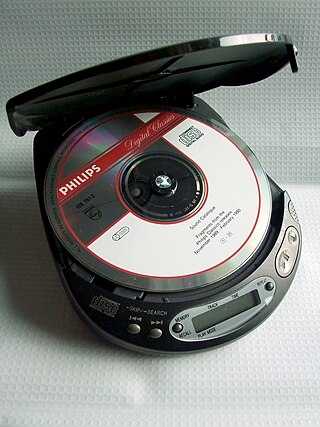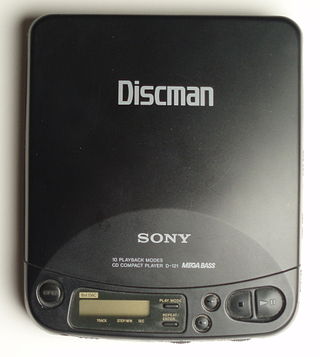
The compact disc (CD) is a digital optical disc data storage format that was co-developed by Philips and Sony to store and play digital audio recordings. It uses the Compact Disc Digital Audio format which typically provides 74 minutes of audio on a disc. In later years, the compact disc was adapted for non-audio computer data storage purposes as CD-ROM and its derivatives. First released in Japan in October 1982, the CD was the second optical disc technology to be invented, after the much larger LaserDisc (LD). By 2007, 200 billion CDs had been sold worldwide.

The PlayStation is a home video game console developed and marketed by Sony Computer Entertainment. It was released in Japan on 3 December 1994, in North America on 9 September 1995, in Europe on 29 September 1995, and in Australia on 15 November 1995. As a fifth-generation console, the PlayStation primarily competed with the Nintendo 64 and the Sega Saturn.

The Compact Disc-Interactive is a digital optical disc data storage format as well as a hardware platform, co-developed and marketed by Dutch company Philips and Japanese company Sony. It was created as an extension of CDDA and CD-ROM and specified in the Green Book specifications, co-developed by Philips and Sony, to combine audio, text and graphics. The two companies initially expected to impact the education/training, point of sale, and home entertainment industries, but the CD-i is largely remembered today for its video games.

The Sega CD, known as Mega-CD in most regions outside North America and Brazil, is a CD-ROM accessory and format for the Sega Genesis produced by Sega as part of the fourth generation of video game consoles. Originally released in November 1991, it came to North America in late 1992, and the rest of the world in 1993. The Sega CD plays CD-based games and adds hardware functionality such as a faster CPU and a custom graphics chip for enhanced sprite scaling and rotation. It can also play audio CDs and CD+G discs.

Walkman, is a brand of portable audio players manufactured and marketed by Japanese company Sony since 1979. The original Walkman started out as a portable cassette player and the brand was later extended to serve most of Sony's portable audio devices; since 2011 it consists exclusively of digital flash memory players. The current flagship product as of 2022 is the WM1ZM2 player.

A CD player is an electronic device that plays audio compact discs, which are a digital optical disc data storage format. CD players were first sold to consumers in 1982. CDs typically contain recordings of audio material such as music or audiobooks. CD players may be part of home stereo systems, car audio systems, personal computers, or portable CD players such as CD boomboxes. Most CD players produce an output signal via a headphone jack or RCA jacks. To use a CD player in a home stereo system, the user connects an RCA cable from the RCA jacks to a hi-fi and loudspeakers for listening to music. To listen to music using a CD player with a headphone output jack, the user plugs headphones or earphones into the headphone jack.

A memory card is an electronic data storage device used for storing digital information, typically using flash memory. These are commonly used in digital portable electronic devices, such as digital cameras as well as in many early games consoles such as the Nintendo Wii. They allow adding memory to such devices using a card in a socket instead of protruding USB flash drives.

In computing, an optical disc drive (ODD) is a disc drive that uses laser light or electromagnetic waves within or near the visible light spectrum as part of the process of reading or writing data to or from optical discs. Some drives can only read from certain discs, but recent drives can both read and record, also called burners or writers. Compact discs, DVDs, and Blu-ray discs are common types of optical media which can be read and recorded by such drives.
In computing, a removable media is a data storage media that is designed to be readily inserted and removed from a system. Most early removable media, such as floppy disks and optical discs, require a dedicated read/write device to be installed in the computer, while others, such as USB flash drives, are plug-and-play with all the hardware required to read them built into the device, so only need a driver software to be installed in order to communicate with the device. Some removable media readers/drives are integrated into the computer case, while others are standalone devices that need to be additionally installed or connected.

Copy Control was the generic name of a copy prevention system, used from 2001 until 2006 on several digital audio disc releases by EMI Group and Sony BMG Music Entertainment in several regions. It should not be confused with the CopyControl computer software copy protection system introduced by Microcosm Ltd in 1989.

Discman was the name for portable CD players. The first Discman, the Sony D-50 or D-5, was launched in 1984. The Sony brand name for Discman changed to CD Walkman, initially for Japanese lineups launched between October 1997 and March 1998, and then entirely in 2000. Discman and CD Walkman players were discontinued at the beginning of the 2010s when they lost popularity with the general public.

Mini CDs, or pocket CDs, are CDs with a smaller diameter and one-third the storage capacity of a standard 120 mm disc.
CD/DVD copy protection is a blanket term for various methods of copy protection for CDs and DVDs. Such methods include DRM, CD-checks, Dummy Files, illegal tables of contents, over-sizing or over-burning the CD, physical errors and bad sectors. Many protection schemes rely on breaking compliance with CD and DVD standards, leading to playback problems on some devices.
key2audio is a copy restriction system for Audio CDs, developed by Sony DADC. The system gained notoriety after it was discovered that one can effectively disable the system by tracing the outer edge of a CD with a felt-tip marker.

Apple PowerCD is a CD player sold by Apple Computer in 1993 and discontinued several years later. It was a re-badged Philips-designed product which was sold in addition to Apple's speakers and also included a remote control. The PowerCD was capable of reading Kodak photo CDs, data CDs and audio CDs. It can connect to Macintosh personal computers through SCSI and also to stereo systems and televisions.

A portable CD player is a portable audio player used to play compact discs. The first audio player released was the Discman D-50 by Sony.

A CD-ROM is a type of read-only memory consisting of a pre-pressed optical compact disc that contains data computers can read, but not write or erase. Some CDs, called enhanced CDs, hold both computer data and audio with the latter capable of being played on a CD player, while data is only usable on a computer.

The Sony Multimedia CD-ROM Player was a portable CD-ROM–based multimedia player produced by Sony and released in 1992. It was used to run reference software, such as electronic publications and encyclopedia. Before its release, both Sony representatives and the press referred to the device as the Sony Bookman; that name remained in use in later publications.
Library of the Future was a collection of public domain texts published on CD-ROM by World Library, Inc. Initially released in 1990, it was one of the first commercial collections of books on CD-ROM. The fourth and final edition was released in 2000 by Ablesoft.

















